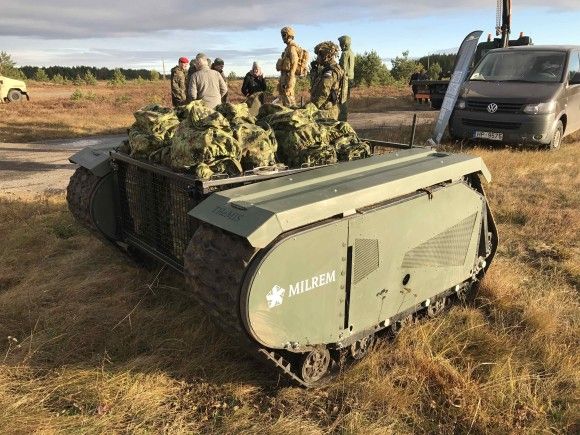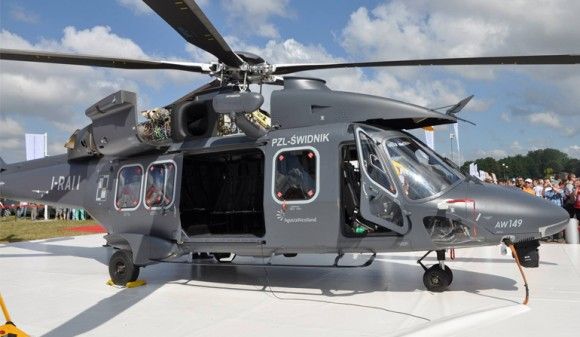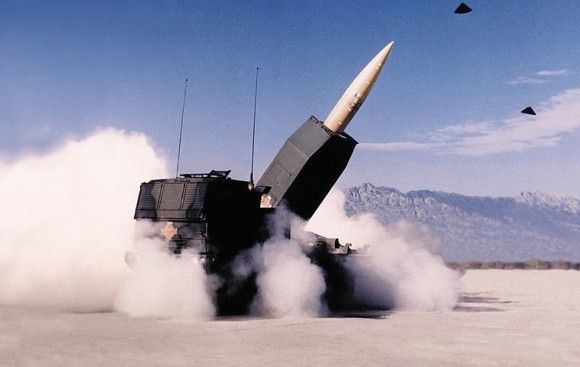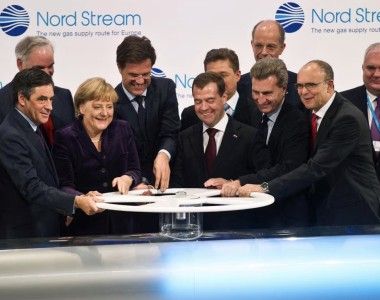“Pocket Artillery” For the Territorial Defence Units. Test Firing Event in Nowa Dęba [Defence24.TV]
The M72 grenade launcher is a prime example of a solution that could become the “pocket artillery” for the territorial defence units. Thanks to the relevant cooperation with the Nammo company, the said weapons system may be, in the upcoming future, manufactured at the Dezamet facility of Nowa Dęba.
Is the mass manufactured grenade launcher, with its heritage rooted back in the times of the Vietnam war, going to become one of the basic elements of the inventory kit used by the Territorial Defence? The representatives of the Nowa Dęba-based Dezamet company, as well as the officials representing the Nammo and Nammo Polska business units, jointly promote the latest variant of the M72 EC LAW (Enhanced Capacity Light Anti-Armor Weapon) system, trying, primarily, to gain attention of the new component of the Polish Armed Forces – WOT (the Territorial Defence units).
Leszek Pabian, technical director and member of the board at the ZM DEZAMET facility told us, that should the said offer be positively accepted by the Polish Ministry of Defence, the deliveries of the grenade launchers for the Polish Army may begin by the end of this year. Not only does Pabian consider LAW to be effective, as he also highly values its simplicity, being lightweight and reliable and, should mass production be implemented, LAW will be cheap to acquire, which renders that system to be a serious candidate to become “pocket artillery” of the future Territorial Defence component of the Polish Army, involving 50 thousand soldiers.
So far, around one million of the M72 launchers has been manufactured. The subsequent tens of thousands may be produced as a result of collaboration between the Nowa Dęba company and Nammo, and the Nammo US branch, by a factory based in Poland, which faces a chance of being rejuvenated. “If this weapon meets your expectations, if you come to a conclusion that you want to get it, I may give you my word that we are able to deliver the first couple of thousand combat launchers, simulators and training units by the end of this year. I want to add, that should the scale of the potential orders have an economic justification, we are ready to carry out a polonization of this product in a “top down” manner . The declaration above has been made by Grzegorz Niedzielski, President of the Management Board and General Director of the Nowa-Dęba-based Dezamet company, following the demonstration carried out on 29th March this year at the artillery firing range in Nowa Dęba. The display has been connected to a firing training organized for the first group of Polish soldiers who were allowed to utilize the weapon in field conditions.
The group included the representatives of the 3rd Territorial Defence Brigade, and of several other units of the Polish Army. The demonstration also has seen involvement on the part of the representatives of the Polish Armaments Group and facilities which are to participate in the M72 production programme to be established in Poland.
Not only has an electronic simulator of the M72 system been provided to the soldiers, as training and live systems were also demonstrated, along with two types of warheads - anti-tank one, and one destined to be used to destroy fortified points of resistance. At the distance of 100 meters, paper targets, as well as real objects such as vehicle wreckage, have been arranged.
The combat capabilities offered by the M72 EC LAW launcher were being tested via shooting carried out against the latter objects, with satisfactory results obtained even with a variable, strong wind. The results that were not much worse than those achieved by the Norwegian instructors, were also achieved by the first-time-users, following a short training and 1-2 shots.
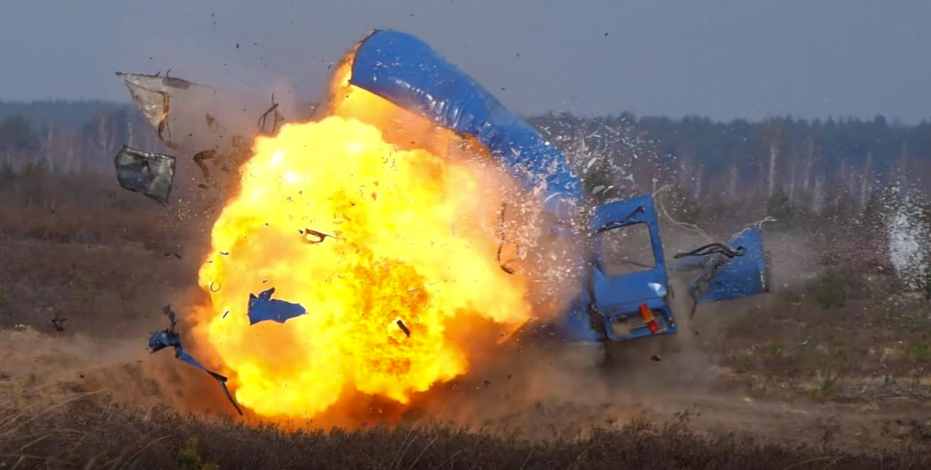
The manufacturing technology, referring to all variants of the M72 launcher, as we were assured by Dominic Jezierski, Technical Director and Chief Engineer working on the Nammo Talley launchers, may be, without any limitations transferred to Poland. The above includes the latest, recently developed variant with an air-blast warhead featuring a smart fuse, as well as currently researched variant ordered by the US SOCOM, allowing the user to safely carry out a fire mission from an enclosed room.
The latter version, within the nomenclature of the company is known under the A8 or A10 designation (depending on the warhead), with a model name as follows: M72 FFE (Fire From Enclosure). The features of this variety of the M72 are to form a response to a potential need, required to complement the equipment kits used by the soldiers in urban combat. M72 FFE is to mainly be characterized by the fact that it generates a sound signature which is much less significant, meanwhile the smoke and flash accompanying the launching event are to be eliminated completely. Recoil of the weapon following the launch has also been significantly diminished.
This is a result of the fact that the former variants have utilized a different type of propulsion system, as compared to the one used now, which much resembles rather a recoilless rifle than a classic rocket launcher. Similarly as in case of the AT4 CS weapon, the M72 FEE features no rocket engine, it uses a propellant and a balancing mass which, at the moment when the propellant is lit up, is exposed to pressure and then launched in a direction opposite to the movement of the projectile. According to the manufacturer, all of the assumed parameters could have been achieved without increasing the cost related to the combat performance, i.e. without reducing the projectile muzzle velocity which, depending on the warhead, is equal to 200-230 meters per second.
A9 launchers are also tailored to be used in enclosed rooms, with an aluminium, thermobaric 0.63 kg warhead, with a minimized post-launch flash.
The latest M72 launchers are to go through the US qualification tests within 18 months. They may also be offered to Poland simultaneously with the older derivatives that have been manufactured so far. The aforesaid models include heavy and light anti-tank warheads - Mark 1 and Mark 2 - offering armour penetration capabilities of 450 and 350 mm RHA respectively.
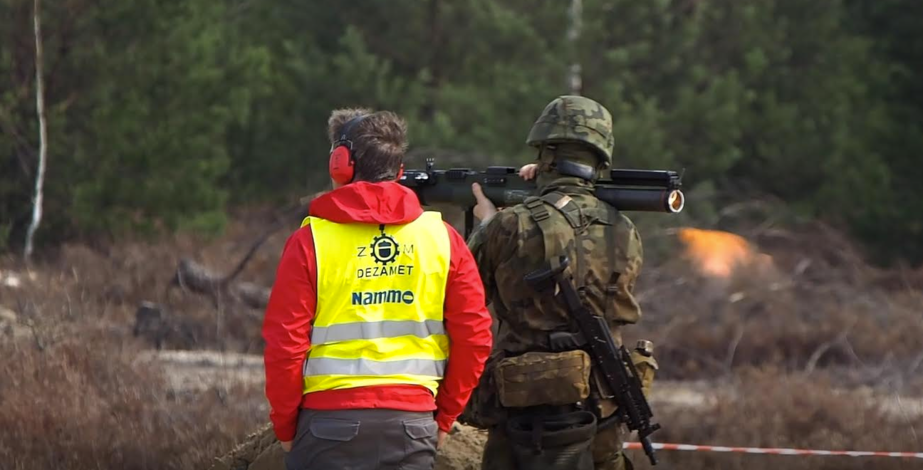
The range of products is complemented by three thermobaric warheads, ABM programmable warheads with a wide fragmentation spread - which may be used to act against e.g. the paratroopers, or a smart fuse air blast warhead which, once it hits the target, carries out an analysis of the target hardness and cohesiveness. If the said parameters have a value which is too high to make it possible for the warhead to penetrate the target, the explosion happens immediately. Meanwhile, if the warhead is able to enter the target structure, then the explosion happens with a delay of 1.5 seconds, inside a vehicle or building. The derivatives of the M72 warheads, destined to act against the personnel, may have two different effects on target. The threats may be hit by e.g. 4 thousand wolfram fragments after the warhead explodes at a programmed point in the air, above the aim point, or after the projectile hits the ground.
300-350 meters is said to be the effective range of accurate fire for the M72 launcher, however, the projectile may be fired as far away, ballistically, depending on the warhead, as to a distances ranging from 1100 to 1600 meters. The minimum range of effective fire, conditioned by the time required to arm the fuse, is as short as 15 meters - and this is also applicable in case of the anti-tank warheads. The combat use experience gathered, e.g. during the Afghan war, concerning the use of anti-tank, shoulder-fired weapons, such as the RPG-7 and its derivatives, indicates that this class of system is not used beyond the distance of 300 meters, with 80 meters being the most frequent distance of use.
The M72 launcher was being designed in a way which makes it possible for the user to effectively attack the targets at distances of up to 300 meters, with a very low cost maintained, offering an ability to penetrate 300-355 mm of RHA. From the moment when the weapon originated, the conditions of combat, as well as the armour capabilities, have been greatly changed. The ongoing development of the M72 projectiles is aimed at rendering the aforesaid limits irrelevant. During the March presentation of the launcher at the Dezamet facility, one could have had a look at armoured plates in case of which, during the research carried out at the local range, the projectiles were able to effectively penetrate 450 mm of armour, with the use of the Mk1 warhead. Dominic Jezierski assures that the 520 mm penetration capability concerning the RHA, is not a result which finalizes the development of the M72 system.
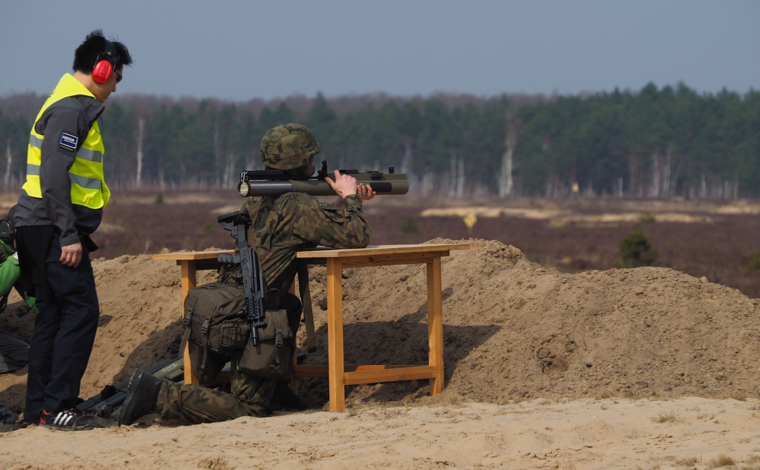
Obviously, and this issue has been raised by some of the officers attending the meeting, the aforesaid parameter is rather modest, concerning most of the contemporary main battle tanks. In case of the RPG-7 the corresponding parameter is equal to 260 mm in case of the older warhead types, and up to 700 mm for the PG-7VR variant. Jezierski admits that Nammo has not been researching the M72 warhead effectiveness, when used against ERA, especially the latest generation solutions of this type. In order to carry out tests as such, one should have an access to original reactive armour that could act as a potential target for the launcher. M72, so far, has only a single anti tank warhead available, when it comes to the ordnance.
Moreover, no experience has been gathered by the company, relevant to assess the effectiveness of using the said weapons system against platforms that utilize ASOP active protection solutions. However, one should remember that the said type of launchers is not being marketed as a specialized weapon that could be utilized against the main battle tanks.
Moreover, no Army in the world exists, operating solely the latest generation armoured assets, with the state of art protection and active countermeasures applied in case of all of the vehicles.
According to the latest recommendations made by the Polish MoD, besides the single use launchers, multiple use systems may also be acquired, which had not been planned beforehand. Solution of this type makes it possible to introduce several types of anti-tank grenade launchers, with a wide and varied scope of capabilities, in case of which the heavier model shall remain capable of acting against main battle tanks an other platforms that could potentially be protected by ERA. In the meantime, the lighter weaponry may be used to act against lighter targets, and to enhance the individual troops’ firepower, should they encounter the enemy infantry.
However, even the tanks fitted with an explosive reactive armour may be damaged and neutralized to some degree, with the use of a single use light grenade launcher. This is possible in a situation, when armament of this type is being utilized in mass quantities, which may only be the case when the procurement costs remain low. The effectiveness is achieved by e.g. hitting the rear, side or top section of the tank, by damaging the drivetrain. This does not change the fact that acting against the main battle tanks is not the primary task of such weaponry. At the same time similar weapons makes it possible to effectively attack most of the Infantry Fighting Vehicles and Armoured Personnel Carriers remaining in use.
Which has been duly noted by one of the officers, the older IFVs, such as BMP-1/2, may be effectively neutralized by .50-cal AP rounds, or even .308 rounds in some circumstances, so the grenade launcher may not even be needed after all, in a situation as such. However, the losses resulting from penetrating the armour with a .50-cal round remain incomparable to the ones we may witness in case of a specialized anti-tank warhead, producing much greater energy after the armour is penetrated, which may, consequently, lead to fuel or ammunition exploding within the vehicle. This obviously multiplies the results of an accurate hit, and usually completely eliminates the target, instead of rendering it temporarily unable to be involved in combat.
During the March presentation taking place in Nowa Dęba, some opinions also emerged that instead of thinking of an entirely new anti-tank system, an RPG-7 modernization programme shall be implemented. Not only is Dezamet in possession of production rights and documentation of the RPG-7, as the facility also has the relevant technological potential at its disposal.
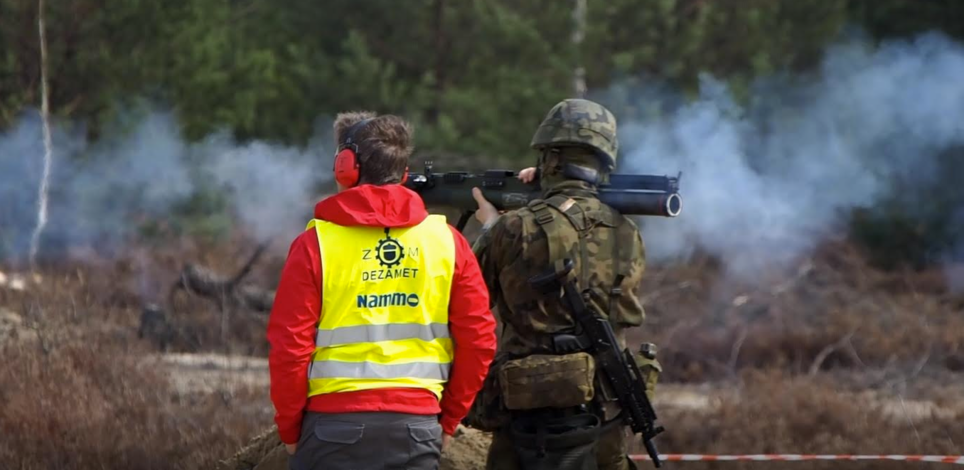
However, the Polish Ministry of Defence has not been asking for deliveries of the ammunition for the said weapons system. Around ten years ago, the facility has undertaken some works on a new generation of warhead, equivalent, i.e. to the PG-7VR variant, however the initiative has ultimately been shut down. The Company has been carrying out the programme, covering the expenditure and bearing the risk on its own, while the Polish MoD was not interested in supporting the initiative. The Ministry did not even decide to unambiguously define its needs and requirements. It is possible that the above resulted from the fact that the new versions of the RPG-7 are offered e.g. by the Bulgarian contractors.
Nammo Talley additionally offers a training system for the M72 launcher, enabling the user to train the troops both within the scope of handling the weapon, as well as within the area of tactics applied in combat. The simulator-based training system is supported and complemented by a system utilizing a 21 mm grenade without an explosive warhead, which is also used for training purposes. For the sake of comparison, we should state that the M72 launcher’s calibre is 66 mm. The training projectile has been fitted with a tracer, allowing the user to track the trajectory of the fired grenade. A large number of training projectiles may be launched from the training launcher, in a very short period of time. This makes it possible to carry out relevant firing training at a shooting distance corresponding with the live munitions (muzzle velocity of the projectile is as high as 210 meters per second). The training variety of the weapon weighs 3.5 kilograms, hence the weight is equal to a combat variant.
The manufacturer also assures that the M72 weapons system may be used to simulate operation of any other weaponry of a similar purpose. Thanks to the above, at a minor cost, one may use the said system to train the operators of other, much more expensive weapons, of a much more complex nature.
M72 is easy to use, and the operation of the weapon includes only a few actions. When the soldier extends the rear part of the launcher, the trigger mechanism is armed, which also extends the sight - thanks to the Picatinny rail, it is also possible to apply optional, removable aiming systems of different types, including laser, reflector or even night vision sights. When the operator pushes the trigger button, the rocket motor of the projectile is initiated. One should note that the propellant is burnt completely, before the missile even leaves the launcher. The projectile does not have a flight motor, during its flight it is aerodynamically balanced by stabilizers deployed once the grenade leaves the launcher. The launcher has been created out of a carbon-fibre-based laminate. It is a single-use system.
Contrary to multiple use grenade launchers, such as the popular RPG-7, leaving the launcher behind after the shot is taken, gives the soldier a much greater freedom of movement, it also allows him to leave the launching location rapidly. Thanks to the design (in a transport setting both ends are covered), the weapon may be stored and transported in virtually any weather conditions, and it remains ready to use immediately. The kit prepared in this way by the manufacturer may be, without any maintenance needs, stored for at least 15 years.
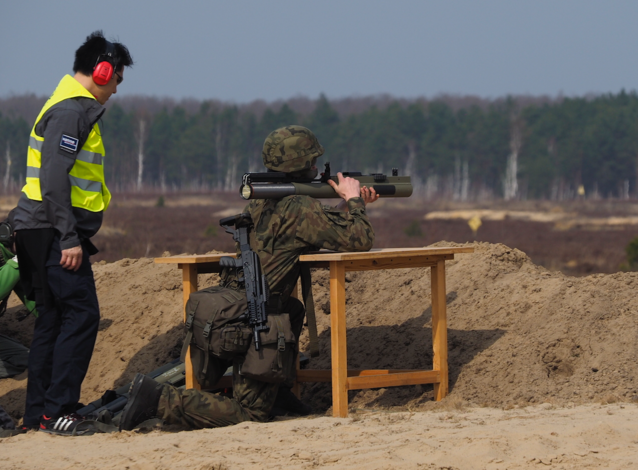
The weapon is portable and small in size. The loaded and ready transport container/launcher, with an integrated iron sight and a launching mechanism, weighs only 3.5 kilograms in the LAW variety. It is only 777 mm long, in a transport setting. For the sake of comparison, the RPG-7 launcher without a grenade has a weight of 6.3 kilograms, its barrel is 650 mm long, while when loaded, the whole system is 1000 mm long.
One of the disadvantages of the M72 may be seen in the fact that the launcher houses a projectile of specific features, with a specific warhead, hence in order to provide the user with an ability to act against a variety of targets, such as armoured vehicles or personnel, several different types of this system shall remain at the disposal of the soldiers. I think that it is going to be worth to have a look at the experience gathered by the Lithuanian Army which has already decided to introduce the M72 into its inventory. There, rules have been established, in line with which the structure of the equipment is going to be created, with the individual types of the launcher being handed to the soldiers in Platoons and Squads - As Nammo Polska Andrzej Dacyl told us. I still see the US 25th Airborne Division commandos in front of me, where each of the soldiers carries 3-4 M72 grenade launchers in a variety of versions on his back, as if LAW had a role identical to a bow of a Native American Indian [going for a hunt].
It is difficult to assess what the cost of manufacturing a single M72 unit may be, in the Polish conditions. At the moment, within the global market, procurement price for this type of weapon is shaped at the level of PLN 10-15 thousand. This makes it possible to start a serious discussion about the cost effectiveness of the acquisition and introduction of such launcher into use.
This is evident, Especially when one compares LAW with other, contemporary anti-tank grenade launchers.
The issue of the cost/combat effectiveness relation has been decisive, when it comes to resignation from any initiative to create M72 launchers with smoke or illumination warheads. In case of the single-use launchers this would be irrational economy-wise, especially in a situation in which such ammunition has been developed for all types of mortars used by the Polish Army, destined to be used as a close support weapon for the elements of the mechanized units, and, most probably, the territorial defence.
The actual cost of production is dependent on the quantities manufactured and the scale of the potential orders, should those orders take place ultimately.
A simple derivation of the above may be seen in the tempo and scope of the economic justification of the individual phases and stages of “Polonization” of the warheads, rocket propulsion systems, fuses and launchers. The main players whose role may turn out to be significant in the process of manufacturing the M72 include, besides the Nowa Dęba company, Gamrat and Mesko facilities. Implementing the technology of production, both with a reference to complete systems, as well as to a variety of warheads, would pave a way towards taking over technologies which would allow the Polish industry to apply modern explosives within the warheads. Here we are referring to Octol. Moreover, the industry could also receive a technology transfer concerning the twin-ingredient M7 rocket propellants.
Dezamet, despite its involvement in other, important programmes such as series manufacturing of 40 mm grenades and introduction of 155 mm artillery rounds for “Krab” and “Kryl”, as well as twin-path works on an automatic 120 mm “Rak” mortar (modification of the OF843B grenades and programme regarding a new HE round), looks forward to invest a lot of its time in the M72 programme, the value of which may be estimated at the level of up to PLN 1 billion.
Jerzy Reszczyński

